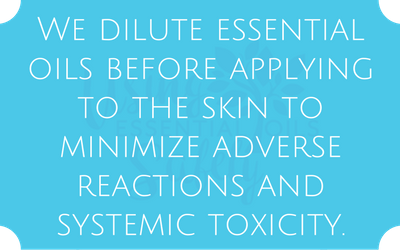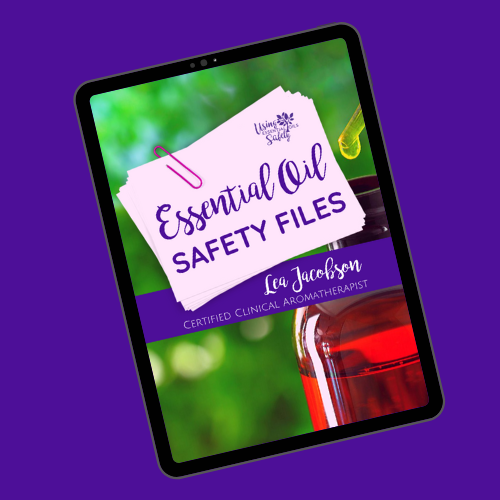ESSENTIAL OIL DILUTION GUIDE STICKERS
Essential Oil Dilution Guide
Always know how to dilute essential oils before applying to the skin! Created by Certified Clinical Aromatherapist Lea Jacobson.
Available while supplies last. Free shipping to US mailing addresses.
Ships worldwide for a nominal shipping fee.
SKIN SAFETY FIRST!
Concentrated substances are rarely intended for use “as is” – and essential oils are no different. There's almost never a time when you would not want to dilute the potency of an essential oil before applying to the skin.
Diluting essential oils is done by adding a drop (or more) of the essential oil into a carrier oil, such as jojoba oil or almond oil. This not only provides a good medium for the oil to absorb into the skin but spreads the oil over a larger surface of your skin for more effect.
Even essential oils with strong safety concerns can be used safely if properly diluted. Knowing how to dilute properly will help you use essential oils safely.

USE TO ENSURE SAFE DILUTION EVERY TIME
-
High Gloss
Glossy sticker shines and looks great anywhere!
-
Water-proof
Yessssss!
-
Fade-proof
No worries about fading - not gonna happen!
-
Fits anywhere!
This convenient 4"x4" size makes it easy to fit inside any book or surface. You can even wrap around your carrier oil bottle!
WHY DILUTE?

Properly diluting essential oils provides a measure of safety against topical irritation, sensitivity, photosensitivity, and sensitization.
Robert Tisserand says, “Essential oil dilution is important for two safety reasons. One, to avoid skin reactions: irritation, sensitization, and phototoxicity. Two, to avoid systemic toxicity, such as fetotoxicity, hepatotoxicity, carcinogenicity, and neurotoxicity. Adverse skin reactions are obvious when they happen, but systemic toxicities may not be. Skin reactions are totally dilution-dependent, and safety guidelines exist to minimize risk.”
In other words, we dilute essential oils before applying to the skin to minimize adverse reactions and systemic toxicity.
HOW DO I KNOW HOW MUCH TO DILUTE?
How much to dilute depends on several factors including, but not limited to:
- the overall toxicity of the essential oil itself, including phototoxicity
- your age
- your health issues, such as bleeding disorders, compromised immune systems, etc.
- if you are pregnant or breastfeeding
- if you have sensitive skin
- if you are using prescription drugs (usually only an issue if using orally, but still a consideration)
Find out the safety issues and topical max dilutions for 240+ essential oils in my best-selling book, Essential Oil Safety Files.
DILUTING BY AGE GROUP
6 – 24 months
(avoid unless urgent)
Please only use for the younger ones in an urgent situation, such as a bee sting or bug bite. Otherwise, avoid using essential oils topically for children under age 2, and use herbs or hydrosols instead. Read: Herbs or Essential Oils – which one should I choose?
2 - 6 years
(0.25% dilution)
Hydrosols and herbs are still a good choice for this age group and should be considered before essential oils. Children in this age group have skin that s getting a bit thicker, and their immune systems are maturing, so it is okay to use essential oils if properly diluted.
over 6 years of age
(1% dilution)
Recommended for children over age 6, pregnant women, elderly adults, those who have sensitive skin, compromised immune systems, or other serious health issues. This is also the dilution you want when you are applying to the face or massaging over a large area of the body.
Average healthy adult
(2% dilution)
Ideal for most adults and in most situations. This is also a good dilution for daily skin care.
Temporary health issues
(3 - 10% dilution)
Best used short term for a temporary health issue, such as a muscle injury or respiratory congestion. For an acute issue, such as a muscle cramp, or severe pain, 25% may be appropriate.
Using oils "neat" or undiluted
Sometimes an essential oil may be used without dilution for acute, short-term issue. A bug bite, burn, or sting, might be a good reason to use an essential oil in this way. Chose wisely, and don't make a habit of this. Not only can some essential oils irritate the skin, but you increase your risk for sensitization.
REMEMBER: the lower essential oil dilution you use, the lower the risk of adverse reactions. Be stingy with high dilutions.
SHARE WITH FRIENDS!
I created these stickers to help you reference how to calculate various dilutions, and I've priced them as low as possible so you can share with a friend!
The best rule of thumb is one drop of essential oil per teaspoon of carrier oil for a 1% dilution.
© 2019 Lea Jacobson, CCA | Using Essential Oils Safely | UEOS, LLC . All Rights Reseved.


